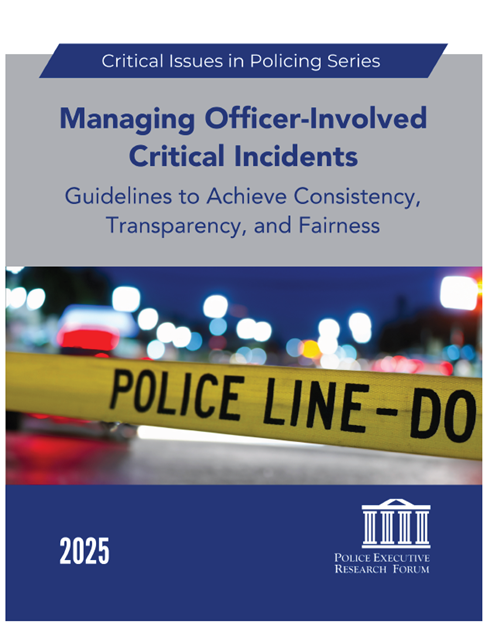|
January 11, 2025 New PERF report on preparing for and responding to officer-involved critical incidents
PERF members, Today PERF is releasing a new publication: Managing Officer-Involved Critical Incidents: Guidelines to Achieve Consistency, Transparency, and Fairness. This report guides chiefs and sheriffs through a situation you all dread: It is three o’clock in the morning and you get a call informing you that one of your officers has been involved in a fatal shooting. You get dressed and are on your way to the scene when you start receiving additional calls. The media wants to know when you’ll release the officer's name and whether they’ve been involved in any prior incidents. A community leader heard rumors that the officer shot an unarmed man and wants to know when he can see the officer’s body-worn camera video. The local prosecutor says she doesn’t want you to interview the officer until she determines whether there will be criminal charges, which you know from prior experience may take months, if not years. The union leader stops you on your way into the scene and says the officer wants to view the video before being interviewed. Your PIO says a citizen has edited an incendiary video of the incident, which is playing on local television and putting pressure on your agency to push your video out quickly. You can feel your blood pressure rising as you approach the scene. Hours later, when you finally leave the scene and arrive at your office, your assistant tells you Anderson Cooper’s booker is on the line and wants to go live with you at 8:00 p.m. If this sounds eerily familiar, you are not alone, and if you have not experienced this yet, it could, unfortunately, take place tonight. Officer-involved critical incidents (OICIs) may not happen as often as the public believes, but when one of these high-profile incidents occurs, you can anticipate all of these issues and many more to surface. From our work over the past 10 years looking at the use of force, PERF has learned a lot about what departments can do to minimize deadly force. Our recent report on restraint, for example, provides easily accessible, practical steps officers can take to reduce the chances of a subject dying during or after being restrained. But these incidents can still occur, even when departments have excellent training and policies in place, so chiefs and sheriffs need best practices for managing OICIs. In late 2023, PERF surveyed its members and interviewed knowledgeable police officials, then held a meeting where experts discussed what agencies are doing to manage these often volatile events. The results of that work are presented in this publication. 
The themes that run throughout are consistency, transparency, and fairness. There should be no surprises about how an agency will handle an OICI. The release of an officer’s name, disciplinary history, and body-worn camera video should be done according to protocols that the agency has developed, formalized, and shared with its officers, the press, and the public. Every agency should have an OICI policy, and we recommend they publish it — and as much other information about OICIs and use of force as possible — in a dedicated and easy-to-find space on their website. To help agencies begin this process or assess their current practices, our publication provides links to many agencies’ policies, examples of the types of information agencies can publicize, and examples of several agencies’ dedicated OICI webpages. Further, we highlight the necessity of law enforcement agencies proactively meeting with stakeholders — including the press, investigative agencies, and prosecutors. This guidebook details the issues that should be resolved during those meetings so that when an OICI takes place, roles are defined and expectations managed from the outset. Transparency practices after an OICI have never been more important. When an officer causes a death or serious injury, regardless of the circumstances or whether their actions were justified, the public expects to learn about the incident and the officer quickly. We recommend that agencies adopt practices to share as much information with the public as soon as reasonable and possible. Our publication shares practices from around the country regarding how best to share information with the public, with an emphasis on transparency. We also share some common pitfalls agency representatives should avoid when talking to the media. The publication provides guidance about the three types of evaluations that need to take place after every OICI: a criminal investigation to determine if a crime took place; an administrative investigation to determine whether there were any violations of policy or training; and an agency-focused assessment to determine whether the OICI revealed the need for changes in agency policy, training, tactics, equipment, or supervision. The results of one investigation should not affect the outcome of others, and we suggest that the criminal and administrative investigations can almost always run concurrently if appropriate barriers are in place. The publication ends with an extremely important chapter — Officer Education and Well-Being. None of the recommendations in the publication should come as a surprise to officers when implemented, because, as we stress, agencies need to do a much better job of preparing their officers for what will occur if they are involved in an OICI during their careers. We provide examples of how some agencies currently prepare their officers. More importantly, we highlight what agencies are doing to support their officers’ well-being in the wake of these critical incidents. And we encourage agencies to do everything they can to implement programs that help their officers deal with the aftermath of these tragic incidents.
PERF’s 2023 meeting on officer-involved critical incidents held in Washington, DC Over the last 10 years, a series of high-profile officer-involved deaths profoundly changed policing in America. The public now expects — and often demands — more from police following critical incidents, regardless of the underlying circumstances. Many police agencies have worked diligently to rise to this challenge. Not every agency will be able to implement every recommendation in this publication immediately, due to collective bargaining, policy, and legal constraints, but this document gathers best practices and prepares police officials for the unfortunate reality that, despite our best efforts to prevent them, officer-involved critical incidents will still occur. Agencies must be equipped to manage these cases in a manner that is consistent, transparent, and fair — to both the public they serve and their own officers. Best, Chuck |

